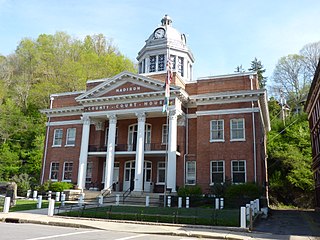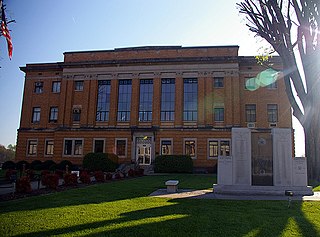
Nashville is a town in Nash County, North Carolina, United States. The town was founded in 1780 and features Victorian and Queen Anne style homes. It is part of the Rocky Mount, North Carolina Metropolitan Statistical Area. The population of Nashville was 5,632 in 2020. It is the county seat of Nash County. The town and its county were named for Francis Nash, an officer of the North Carolina militia who died in the American Revolutionary War.
Francis Nash was a brigadier general in the Continental Army during the American Revolutionary War. Prior to the war, he was a lawyer, public official, and politician in Hillsborough, North Carolina, and was heavily involved in opposing the Regulator movement, an uprising of settlers in the North Carolina piedmont between 1765 and 1771. Nash was also involved in North Carolina politics, representing Hillsborough on several occasions in the colonial North Carolina General Assembly.

Halifax County Courthouse is a historic county courthouse located at Halifax, Halifax County, North Carolina. It was designed by architects Wheeler & Stern and built in 1909–1910. It is a three-story, tan brick, Classical Revival style building. It has a tetrastyle Corinthian order portico flanked by two-story flat roofed wings and a two-stage cupola atop a shallow mansard roof.

The Hyde County Courthouse is a historic courthouse building located at Swan Quarter, Hyde County, North Carolina. It was built in 1854–1855, and is a two-story, T-shaped stuccoed brick building. It has a Victorian style corbelled mousetooth cornice and ornately turned brackets. The courthouse was remodeled in 1878 and 1909 and drastically renovated in 1964.

Hillsborough Historic District is a national historic district located at Hillsborough, Orange County, North Carolina. The district encompasses 529 contributing buildings, 9 contributing sites, 13 contributing structures, and 2 contributing objects in the central business district and surrounding residential sections of Hillsborough. The district includes buildings dating to the late-18th and early-20th century and includes notable examples of Federal, Greek Revival, and Italianate style architecture. Located in the district are the separately listed Burwell School, Eagle Lodge, Hazel-Nash House, Heartsease, Montrose, Nash Law Office, Nash-Hooper House, Old Orange County Courthouse, Poplar Hill, Ruffin-Roulhac House, Sans Souci, and St. Matthew's Episcopal Church and Churchyard. Other notable buildings include Seven Hearths, the Presbyterian Church (1815-1816), Methodist Church (1859-1860), First Baptist Church (1862-1870), Twin Chimneys, and the Berry Brick House.

The Chatham County Courthouse is a historic courthouse located at Pittsboro, Chatham County, North Carolina. It sits at the center of town in the middle of a traffic circle. It was built in 1881 for $10,666 and is a two-story rectangular brick structure in the Late Victorian style. It features a two-story classical portico crowned with a distinctive three-stage cupola. A one-story addition was built in the 1930s by the Works Progress Administration. In 1959, extensive renovations were performed on the building.

The U.S. Post Office and Courthouse, also known as Statesville City Hall, is a historic post office and courthouse building located at Statesville, Iredell County, North Carolina. It was designed in the Richardsonian Romanesque style by Willoughby J. Edbrooke and built in 1891. It is a rectangular 2 1/2-story structure, seven bays wide, and three bays deep. It is constructed of red brick and sandstone. The building has a two-story corner tower, one-story entrance pavilion with central arched recessed entrance, and a tall hip roof.

The Iredell County Courthouse is a historic courthouse building located at Statesville, Iredell County, North Carolina. It was built in 1899, and is a two- to three-story, square Beaux Arts building. It is sheathed in yellow brick and consists of a center five-bay wide three-story block, topped with a mansard cupola and fronted by a two-story tetrastyle pedimented portico, and flanking one-bay wide two-story wings.

Alleghany County Courthouse is a historic courthouse building located at Sparta, Alleghany County, North Carolina. It was built in 1933, and is a two-story, H-shaped Classical Revival style brick building. The front facade features a tetrastyle Tuscan order portico. It was built after "The Big Fire" of 1932 destroyed the courthouse and a block of businesses and homes.

Gaston County Courthouse is a historic courthouse building located at Gastonia, Gaston County, North Carolina. It was designed by Milburn, Heister & Company in 1909 and built in 1910. It is a three-story, rectangular, Classical Revival style tan brick building with a rear addition. It features pedimented porticoes supported by Ionic order columns, a heavy modillion and dentil cornice, and three-sided pavilions on the side elevations. The building was renovated in 1954.

Granville County Courthouse is a historic courthouse building located at Oxford, Granville County, North Carolina. It was built in 1838, and is a two-story, "H"-shaped, Greek Revival style brick building. It has a three bay central pavilion and a polygonal cupola with a domed room.

Madison County Courthouse is a historic courthouse building located at Marshall, Madison County, North Carolina. It was designed by noted Asheville architectural firm of Smith & Carrier and built in 1907. It is two-story, brick, Classical Revival style building. It has a hipped roof topped by a four-stage polygonal cupola. The front facade features a tetrastyle pedimented Corinthian order portico.

McDowell County Courthouse is a historic courthouse building located at Marion, McDowell County, North Carolina. It was designed by architect Erle G. Stillwell and built between 1921 and 1923. It is three-story, late Neoclassical building sheathed in yellow brick. The rectangular structure is composed of a central block flanked by slightly recessed, unornamented wings.

Nashville Historic District is a national historic district located at Nashville, Nash County, North Carolina. It encompasses 142 contributing buildings and 3 contributing structures in the rural county seat of Nashville. The buildings primarily date between 1890 and 1930, and include notable examples of Greek Revival, Italianate, Queen Anne, Colonial Revival, and Classical Revival style architecture. Located in the district are the separately listed Bissette-Cooley House and Nash County Courthouse. Other notable buildings include the Graphic Building, Baldy Batchelor Livery Stable, Weldon's Department Store (1913), Ricks-Strickland House (1890s), Squire Harper House (1868), two metal-veneered "Lustron houses," Neville-Strickland House (1907), Primitive Baptist Church, First Methodist Church (1923), and former Baptist Church.

Nash Law Office is a historic office building located at Hillsborough, Orange County, North Carolina. It was built in 1801, and is a small one-story, frame building with a gable roof and low brick foundation. It has a brick exterior end chimney and a small one-story wing added in 1865. The building housed the law office of jurist Frederick Nash (1781-1858). Following his death it housed a school and was purchased by the Hillsborough Historical Society in 1970.

Perquimans County Courthouse is a historic courthouse building located at Hertford, Perquimans County, North Carolina. It was built between 1819 and 1825, and is a 2+1⁄2-story, four-bay, Georgian style brick building. It has a T-shaped plan, with late 19th- and 20th-century rear additions. The front facade features a one-story, one-bay pedimented portico with molded brick columns.

Surry County Courthouse is a historic courthouse building located at Dobson, Surry County, North Carolina. It was designed by architect Harry Barton and built in 1916. It is a three-story, rectangular Classical Revival style tan brick building. The five bay front and rear elevations feature a central entrance flanked by pairs of Ionic order pilasters. Two-story wings were added to the main block in 1971.

Transylvania County Courthouse is a historic courthouse building located at Brevard, Transylvania County, North Carolina. It was built in 1873, and is a two-story, "T"-plan Italianate style brick building with a hipped roof. It has a rear addition built in the early-20th century. The front facade features a projecting three-story tower topped by a concave mansard roof.

Tyrrell County Courthouse is a historic courthouse building located at Columbia, Tyrrell County, North Carolina. It was built in 1903, and is a two-story, Italianate style brick building with a hipped roof. It has gabled, parapetted wall dormers; windows with segmental and round arches; and flat roof porch supported by paired columns dated to the 1970s.

The former Vance County Courthouse is a historic courthouse building located at Henderson, Vance County, North Carolina, United States. It was originally built in 1884, before it was extensively remodeled in 1908 by Milburn, Heister & Company in the Neoclassical style. It is a two-story, tan brick, cross-plan building with a monumental front portico supported by brick columns.























